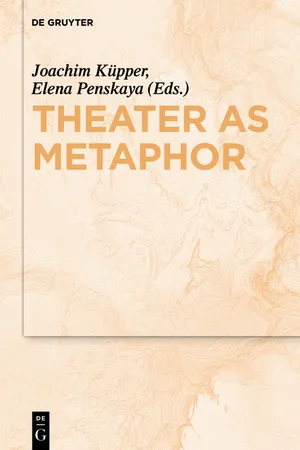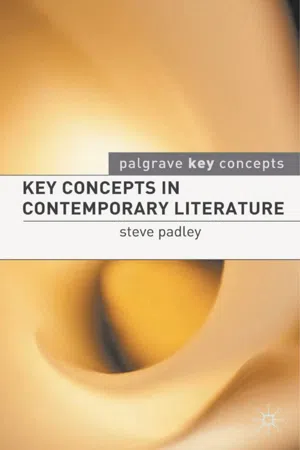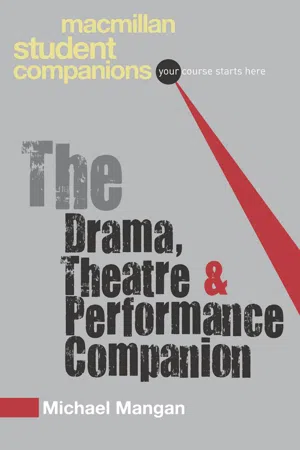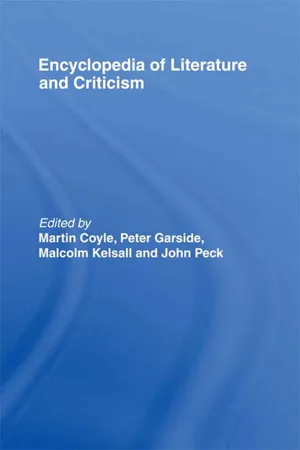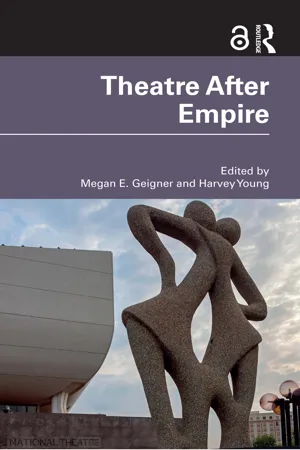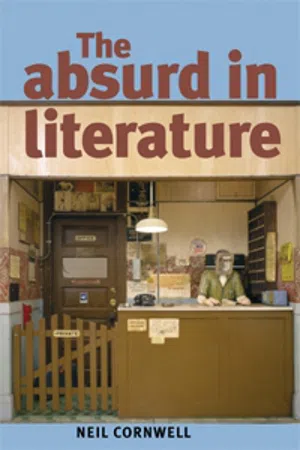Literature
Theatre of the Absurd
The Theatre of the Absurd is a literary movement that emerged in the 1950s, characterized by its exploration of the absurdity and meaninglessness of human existence. Playwrights like Samuel Beckett and Eugene Ionesco created works that featured nonsensical dialogue, illogical situations, and a sense of existential despair. The movement aimed to challenge traditional theatrical conventions and provoke audiences to question the nature of reality and the human condition.
Written by Perlego with AI-assistance
10 Key excerpts on "Theatre of the Absurd"
- eBook - ePub
- Elena Penskaya, Joachim Küpper, Elena Penskaya, Joachim Küpper(Authors)
- 2019(Publication Date)
- De Gruyter(Publisher)
8All of the relevant concepts remained attached to these thoughts, defining the theater of the absurd as theater that first and foremost exposes the absurdity of the human condition, defining the plays as having “in common the basic belief that man’s life is essentially without meaning or purpose and that human beings cannot communicate”.9 Encyclopedias such as Britannica define the genre as the works of playwrights who expressed a “postwar mood of disillusionment and scepticism […] in bizarre terms” and of authors who “shared a belief that human life was essentially without meaning or purpose and that valid communication was no longer possible. The human condition, they felt, had sunk to a state of absurdity […].”10 Furthermore, the theater of the absurd is also seen as a literary response to World War II and the Shoa,11 to “the modern world shaken in its traditional beliefs and in grave doubt as to the meaning of existence and the possibility of communication between men […]”.12 In Germany, where the reception of absurdist plays was particularly strong, scholars—although they highlighted Beckett’s and Ionesco’s rupture with traditional forms of theater—even explicitly mentioned in their compendia that the expression “absurdes Theater” was wrong in terms of the logic of language, because the claim is not that it is theater that is absurd, but rather the plot embodying the “metaphysical homelessness” and the “social alienation of mankind”.13 Whenever the lack of theatrical logic and conventional structure in the plays was noticed, critics used to argue that the form was above all absurd in order to support the absurd content.14 The absurd dramatic form seemed to be nothing more than the appropriate form for the representation of the absurdity of the world. The “concept of homo absurdus ”15 - eBook - ePub
Camus' Literary Ethics
Between Form and Content
- Grace Whistler(Author)
- 2020(Publication Date)
- Palgrave Macmillan(Publisher)
2015 , 350)Tragedy and comedy are thus two sides of the same coin in this kind of theatre, and this confrontation between humans and our mortal condition is cathartic—watching this kind of play allows us to witness the world in all its madness, and nevertheless see the hilarity of it.Esslin credits Camus with having formulated the conceptual foundation for this kind of theatre, citing Camus’ own remarkably theatrical definition of the absurd : ‘This divorce between man and his life, the actor and his setting, is properly the feeling of absurdity’ (Camus 2005 , 4–5). This lineage has rightly been observed by numerous scholars, such as Sophie Bastien , who suggests that ‘the authors of the theatre of the Absurd are perhaps those who have benefited from Camus’ thought in the most positive way’ (Bastien 2007 , 89).1 Esslin points out that ‘the plays we are concerned with here pursue ends quite different from those of the conventional play and therefore use quite different methods’ (Esslin 2015 , 4)—much like (as I have argued throughout this volume) Camus’ philosophical venture. However, Esslin claims that Sartre and Camus,differ from the dramatists of the Absurd in an important respect: they present their sense of the irrationality of the human condition in the form of highly lucid and logically constructed reasoning, while the Theatre of the Absurd strives to express its sense of the senselessness of the human condition and the inadequacy of the rational approach by the open abandonment of rational devices and discursive thought. While Sartre or Camus express the new content in the old convention, the Theatre of the Absurd goes a step further in trying to achieve a unity between its basic assumptions and the form in which these are expressed. In some senses, the theatre of Sartre and Camus is less adequate as an expression of the philosophy of Sartre and Camus—in artistic, as distinct from philosophic, terms—than the Theatre of the Absurd . (Esslin 2015 - eBook - ePub
- Steven Padley(Author)
- 2006(Publication Date)
- Bloomsbury Academic(Publisher)
The concept of the absurd that flourished in European drama in the 1950s and early 1960s also had some degree of influence on British theatre over the same period. The movement drew heavily on the philosophical definition of ‘absurdity’ associated with existentialist thinkers such as Albert Camus. For Camus, human beings were adrift in the chaos of an empty and meaningless universe, in which the comforting illusions of faith and reason could no longer offer consolation. Absurdity in this context derived out of humanity’s yearning for those consolations, and it was absurdity that defined the human condition at this point in history. In this analysis, human beings were isolated and alienated from the world around them; the Theatre of the Absurd sought to dramatise this condition.The plays of absurdist theatre’s main exponents, Eugene Ionesco, Samuel Beckett and Jean Genet, reflected the absurdity of human existence in the form as well as the content of their plays, rejecting dramatic conventions of plot cohesion, naturalistic settings, psychologically consistent characterisation and rational dialogue. Ionesco’s The Bald Prima Donna (1958) and Beckett’s hugely influential Waiting for Godot (1953) featured repetitive, inexplicable action and dialogue, demonstrating a lack of connection between characters that verged at times on the nonsensical, evoking a lost and bewildered state of humanity. Vladimir and Estragon, the two tramps who are the main protagonists of Waiting for Godot, for example, are unsure of whom they are waiting for and why, and even how long they have been waiting. The play’s two acts contain many similarities, though the tramps give few indications that they are aware of this, despite encountering the same characters in both acts. Beckett’s play clearly reveals the influence of popular forms of comic entertainment, such as mime, slapstick and circus-clown-style antics on absurdist drama, but the fundamental existential despair underlying the characters’ words and actions reveal the greater tragic dimension of the genre (Godot - eBook - ePub
Politics and Theatre in Twentieth-Century Europe
Imagination and Resistance
- M. Morgan(Author)
- 2013(Publication Date)
- Palgrave Macmillan(Publisher)
The Theater of the Absurd neatly sums up this sensibility and the new form of theatre to which it gave rise. As Esslin points out, this genre of theatre was less the result of a conscious movement than the manifestation of a convergence of strikingly similar styles. The playwrights in question—Ionesco, Beckett, Adamov, and Genet—did not consider themselves part of a common enterprise, and each indeed privileged his individualism and his uniquely personal view of the world and the theatre. This experimentation was centered in Paris, whose cultural life—particularly its hospitality to émigré artists such as Adamov, Beckett, and Ionesco—allowed extensive creative freedom. Despite the individual experiences of isolation and marginality that these writers shared, the plays of these “absurdists” bore striking resemblances to each other. And if they gave voice to a sense of the contingency of things powerfully articulated by the existentialists, they also sounded this theme in a way dramatically different from existentialism with its humanistic hopefulness.At the root of their commonality lay their concern with the absurd, a concept previously identified by Albert Camus and discussed by the existentialist philosophers. For Camus, “[the] divorce between man and his life, the actor and his setting, truly constitutes the feelings of Absurdity.”7 The situation of the exile, caught between his homeland, to which he cannot return, and the promise of a new home, which is not to be found, is absurd. And for the absurdists this experience—which many of them, especially Ionesco, Adamov, and Beckett, experienced firsthand—was the essential and inalterable human experience. As Ionesco wrote, echoing Camus, “Absurd is that which is devoid of purpose . . . Cut off from his religious, metaphysical, and transcendental roots, man is lost; all his actions become senseless, absurd, useless.”8 - eBook - ePub
- Michael Mangan(Author)
- 2013(Publication Date)
- Methuen Drama(Publisher)
3Key concepts
Introduction3This section of the book covers some of the common subject terms and concepts which students of Drama, Theatre and Performance studies might expect to come across in their reading and research. It ranges over a number of areas and methodologies within the subject and seeks both to introduce some new material and also to throw new light on some apparently familiar concepts.While some of the terms are fairly straightforward, others are contested or controversial, and many of the entries start by defining the term – or by saying how hard it is to define it or by pointing to the fact that the term may be used differently in different contexts by different people. While these short entries will not go deeply into their subject matter I will try to put concepts into context and note how they have been applied or developed.Absurdism (Theatre of the Absurd)This term was coined by the influential critic Martin Esslin, whose book Theatre of the Absurd defined a group of primarily European playwrights writing in the 1950s and 1960s, including Eugene Ionesco, Samuel Beckett, Jean Genet and Arthur Adamov. Esslin links the term to mid-twentieth-century existentialist philosophy and in particular to the writings of Albert Camus. In existentialist thinking, ‘the absurd’ is that which appears on the face of things to be amenable to reason but which actually turns out to be beyond the limits of rational thought. Camus (who actually rejected the label ‘existentialist’ and also lost interest in the whole notion of the absurd) came closest to defining his sense of the absurd in The Myth of Sisyphus, - eBook - ePub
- Martin Coyle, Peter Garside, Malcolm Kelsall, John Peck(Authors)
- 2002(Publication Date)
- Routledge(Publisher)
Theatre is the most social of art forms and, as such, requires a great many conventions so that the theatrical event, on and off the stage, can take place in an orderly fashion. We know from history that festivals in Ancient Greece were highly organized. It was also in Ancient Greece that the theoretical foundations of our western theatre were laid and, twenty-five centuries on, the name of Aristotle is still invoked, rightly or wrongly, in discussions concerning the structure of drama. Although the Anglo-Saxon world escaped the worst excesses of neo-classical formalism, mainly thanks to the influence of Shakespeare, the rules that came to govern French seventeenth-century theatre (unities of time, place and action; unity of tone; verisimilitude and decorum) aimed at creating an orderly, coherent, harmonious, rational dramatic poem. These same rules came to embody the ideal of playwriting throughout the western world after neo-classicism established itself as the dominant aesthetic norm in the seventeenth century. A good play was a play with a strong, straightforward plot moving relentlessly to its logical, tragic or comic, conclusion, with clearly drawn and highly individualized characters, with well-written, rhetorical dialogue, to be clearly and evocatively spoken by actors who convincingly portrayed their roles in a familiar setting or in some easily identifiable exotic location. Such were the ideals upheld by all dramatists hoping to have their plays performed in the theatre, from Aeschylus to Ibsen. At the risk of further oversimplification, it can be said that, before the twentieth century, the dramatic form was eminently logical and rational (even when dealing with extraordinary events) and that it aimed at providing spectators with an authentic picture of their world. When our forebears recognized that the world was in a state of chaos—and they often did—their artists aimed at constructing meaning out of that same chaos, at creating order out of disorder, at giving shape to what is shapeless. The –New Theatre’ of the 1950s, soon to be known as –the Theatre of the Absurd’, overturned twenty-five centuries of tradition by rejecting all rules and by facing the chaos head-on.‘The feeling of the absurd can strike anyone round the corner of any street’, wrote Albert Camus inThe Myth of Sisyphus ([1942] 1975, p. 17), thereby putting the term –absurd’ at the centre of philosophical debate and at the forefront of artistic reflection for years to come. For Camus –the feeling of the absurdity of the world’ springs from the confrontation between man’s conscience, his consciousness, his thirst for rationality and the inert, irrational, unknowable world. Yet, contrary to received ideas, the realization of such an irredeemable divorce does not lead to passive despair or intellectual suicide. Convinced of the ultimate absurdity of life, man will strive towards a moral and ethical imperative for greater lucidity and for living life to the full, since life is, after all, the only human tangible reality.Camus’s most despairing play, Cross Purpose (Le Malentendu, 1944), tells of the murder of a young man by his long-lost mother and sister who fail to recognize him in the lone traveller come to spend the night in their inn. Constructed like a mathematical equation, Cross Purpose, has a simple, realistic set, a small cast of well-defined characters, a relentless action that lasts just a few hours, and contains not the slightest incident that could distract the spectator’s attention from the subject under scrutiny. Well played, this becomes a metaphysical tragedy of the highest order, stating that –this world we live in doesn’t make any sense’. The same clarity of meaning is also the hallmark of Camus’ other plays, and of the dramatic output of his fellow existentialist Jean-Paul Sartre whose In Camera (Huis clos - eBook - ePub
- Megan E. Geigner, Harvey Young, Megan E. Geigner, Harvey Young(Authors)
- 2021(Publication Date)
- Routledge(Publisher)
3 ABSURDIST THEATRE GOES POSTCOLONIAL Trans-Contextuality, Absurd Jokes, and Evocation in (Post)colonial Plays Mina Kyounghye Kwon Immediately after World War II, a group of European playwrights (including Irish playwright Samuel Beckett, Romanian-French playwright Eugène Ionesco, and ex-prisoner playwright Jean Genet), mostly living in France as outsiders, produced plays that were soon categorized as the Theatre of the Absurd by theatre scholar Martin Esslin. 1 The Theatre of the Absurd, although it was not a conscious movement declared by these playwrights, was the most prominent avant-garde theatre genre of the 1950s and 1960s. 2 Scholars generally agree that absurdist theatre grew out of the postwar zeitgeist, responding to the atrocity and human cruelty of World War II and/or expressing an outsider’s perspective on language and social structures. 3 The 1950s and 1960s also ushered in the era of decolonization, during which many nations in Africa, Asia, and the Caribbean gained independence. 4 In the following decades, especially the 1970s, marked by Edward Said’s seminal publication of Orientalism in 1978, many postcolonial 5 and Indigenous 6 cultures began to engage in the process of self-determination. As this essay will illustrate, the emergence of playwrights in these (post)colonial 7 regions coincided with the post-World War II heyday of absurdism as the premier avant-garde theatre genre. In addition to the historical convergence, both absurdist playwrights and certain postcolonial playwrights engaged comparable sentiments, such as alienation, displacement, and absurdity, largely owing to World War II and colonial legacies, respectively - eBook - ePub
English Literature
A Student Guide
- Martin Stephen(Author)
- 2013(Publication Date)
- Routledge(Publisher)
1937) is also often linked with this group. These dramatists shared a belief that human life was essentially irrational, purposeless, and out of harmony with its surroundings, the result of this being a chronic state of uncertainty, anguish (angst), and depression. Other authors had reached this conclusion before; none had allowed it to dictate the form of their work as well as its content. Absurdist plays can drop all logic and rationality, and allow absurd, illogical, or irrational things to happen on stage in order to illustrate the central thesis that this is the nature of life. The opening shot in this revolution was fired by Samuel Beckett’s Waiting for Godot (1953), which shocked theatre audiences at first by its absence of plot or structure, its bare set, and its central concept that ‘nothing happens’. Absurd drama could be seen as a blend of surrealism and farce. An excellent example is Ionesco’s Rhinoceros (1960), in which people keep turning into rhinoceroses, whilst others frantically try to ignore the fact. In the novel, works such as The Trial (1925) and Metamorphosis (1912) by Franz Kafka (1883–1924) have absurdist elements in them. AESTHETICISM and DECADENCE: the Aesthetic Movement originated in France in the latter part of the nineteenth century, and in English literature its best-known adherents are Oscar Wilde (1854–1900), Algernon Swinburne (1837–1909) and the artist Aubrey Beardsley. The Aesthetes believed in ‘art for art’s sake’, and the pursuit of beauty to the exclusion of all else, particularly materialistic or worldly values. The Aesthetic Movement was closely linked with the Decadent Movement, with its search for exquisite sensations, its hatred of all that was ‘natural’ and its obsession with high artifice. Aesthetes and Decadents were associated with the flouting of conventional morality. AFFECTIVE FALLACY: the attempt to evaluate a poem by its emotional effect upon the reader - eBook - ePub
- Neil Cornwell(Author)
- 2013(Publication Date)
- Manchester University Press(Publisher)
The Bus Driver , 91–130). Another further reach of weirdness is attained in Ronshin’s miniature ‘How I Became a Fly’ (67–70), in which the narrator, a shopkeeper, is dismembered and metamorphosed at the hands of a ‘strange customer’.Beyond the ‘Theatre of the Absurd’?
a world of chaos need not be dreaded … (William W. Demastes, Theatre of Chaos)A bizarre hybrid specimen of fiction, which would seem to require at least a brief comment here, were it only on the grounds of its title,15 is Karen Cobb’s gay novel Theatre of the Absurd (1995), set in San Francisco’s theatre world, in which the framing prose fictional plot surrounds, interacts with, influences and is influenced by, the play within this plot – a stylised harlequinade called ‘The Struggle for Creation’. ‘Theatre of the Absurd’ is here used by Cobb as both a metaphorical and a literal device to project the personal obsessions of a bisexual playwright and other self-fixated theatricals, reduced sharply towards, and destructively beyond, the absurd and its theatre. Something of a reverse of this structural model is to be found in Martin McDonagh’s The Pillowman (2003), in which a number of stories are embedded (and narrated or read) in an extremely black comic play, to which we shall return shortly.Women’s absurd?
There seem to have been few women absurdist writers – a question addressed by Toby Silverman Zinman (in Brater and Cohn, 203–20); one, however (in Zinman’s view) is the Cuban-born playwright Maria Irene Fornes. While, to an extent at least, employing absurdist linguistic techniques, women writers are seen as avoiding, or rejecting, the pessimistic and abstract philosophies entailed in absurdism (a strident exception to this, however, to be considered later, is Sarah Kane). Caryl Churchill, who combines the (postmodernist) transhistorical gathering with contemporary social satire (in Top Girls - eBook - ePub
- Paul I. Trensky(Author)
- 2017(Publication Date)
- Routledge(Publisher)
Maids. Sergej Machonin commented on the belated staging of these plays, most of which were written more than a decade earlier and which have, in the meantime, lost their character of rebellion:Something most absurd has happened to the theater of the absurd that fifteen years ago went to war against all theater of the past as well as that of the present in order to laugh at and to ridicule it, in order to put a load of dynamite under it and shatter it to pieces with anger and contempt. Prague came to look at this theater, which in the 1950's was synonymous with the ultramodernist avant-garde, as if it were a historical curiosity. People were saying to themselves: Finally we shall see how it really was.1The reasons for the lateness in arrival of the absurd drama on the Czech stage were several. The absurd drama of the West was naturally well known to the leading men of the theater in Czechoslovakia long before it began to be produced. Informative studies on the movement can be found in Czech professional journals as early as in the late 1950's, but it was one thing to discuss the movement in theoretical studies and quite another to stage or publish translations of the plays. The establishment regarded the Parisian avant-garde of the 1950's as representing Western decadence of the worst kind, but even progressive non-Marxist directors were in no hurry to include the absurd drama in their repertoire. The years immediately following the fall of the Stalinist cult were filled with relative optimism as regards man's capabilities to rationally organize his world. The drama was preoccupied with the exploration of uniqueness in man and with the formulation of a new humanism. The works of Ionesco, Beckett, Pinter, or Adamov were felt to be ill-suited for the objectives of this era. There can be little doubt also that the provocatively revolutionary forms of this theater made the directors proceed with caution, since during this period even certain prewar conventions were regarded by the Czech public as innovative. It appears that the condemnation of the absurd drama by some leading Western critics, including some non-Marxists, contributed considerably to its belated reception in Czechoslovakia. The famous invectives of Kenneth Tynan, who characterized representative members of this theater as apostles of antirealism perennially preoccupied with the creation of a "bleak new world from which the humanist heresies of faith in logic and belief in man will forever be banished,"2
Index pages curate the most relevant extracts from our library of academic textbooks. They’ve been created using an in-house natural language model (NLM), each adding context and meaning to key research topics.
Explore more topic indexes
Explore more topic indexes
1 of 6
Explore more topic indexes
1 of 4
